Understanding the difference between ASOS and AWOS is critical for anyone involved in aviation—from pilots planning flights to airport managers choosing weather monitoring systems. These two automated weather observing tools are the backbone of safe flight operations, providing real-time meteorological data that prevents accidents and streamlines air traffic. Yet, many in the industry struggle to distinguish between their capabilities, use cases, and benefits. In this blog, we’ll break down what ASOS and AWOS are, their core differences, and how to choose the right system for your needs—plus, how Haisen’s aviation weather solutions enhance both platforms.
1. Introduction: Why ASOS and AWOS Matter in Aviation
Weather is the single most influential factor in flight safety. Turbulence, low visibility, sudden wind shifts, or unexpected storms can turn a routine flight into a crisis. This is where Automated Surface Observing Systems (ASOS) and Automated Weather Observing Systems (AWOS) come in. Both systems eliminate the risk of human error in manual weather reporting, operate 24/7, and deliver instant data to pilots, air traffic controllers (ATCs), and airport operations teams.
But the difference between ASOS and AWOS isn’t just in their names—it’s in their scope, functionality, and ideal use cases. Choosing the wrong system can lead to incomplete data (endangering flights) or unnecessary costs (wasting resources on unused features). Whether you’re a small regional airport on a budget or a major international hub managing hundreds of daily flights, understanding these differences is key to prioritizing safety and efficiency.
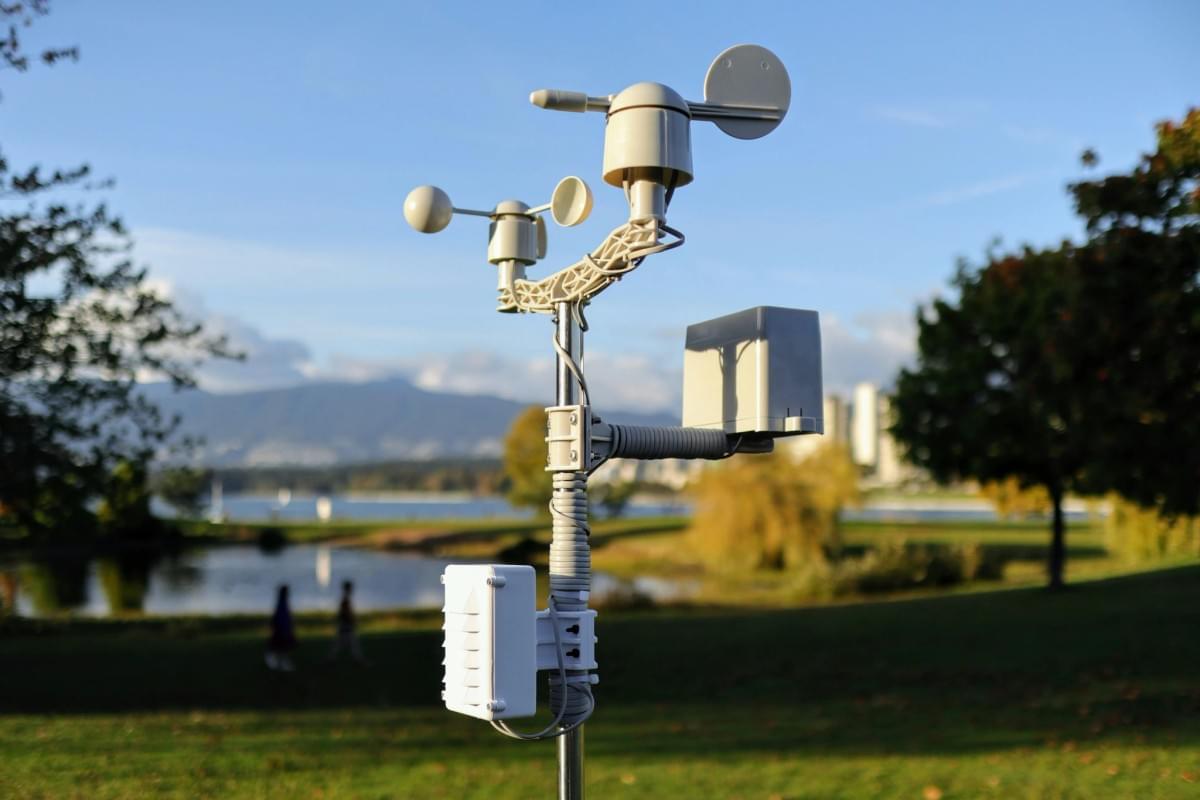
2. What Is ASOS? A Deep Dive into Automated Surface Observing Systems
ASOS stands for Automated Surface Observing System—the gold standard for comprehensive weather monitoring at large, high-traffic airports. Developed to meet strict aviation industry standards, ASOS is designed to capture a wide range of meteorological parameters, integrate with critical aviation tools, and support complex flight operations.
2.1 Core Definition of ASOS
ASOS is a fully automated system that continuously collects, processes, and disseminates real-time surface weather data at airports. Unlike manual observations (which rely on human observers and are prone to delays or errors), ASOS operates without interruption—providing consistent, accurate data 365 days a year, 24 hours a day. Its primary goal is to give pilots and ATCs a complete picture of current weather conditions, enabling informed decisions about takeoffs, landings, and route adjustments.
2.2 Key Features of ASOS
What sets ASOS apart from other weather systems is its depth of functionality and integration with aviation infrastructure. Here are its most critical features:
- Comprehensive Parameter Monitoring: ASOS tracks more meteorological data than AWOS, including:
- Temperature, dew point, and relative humidity
- Wind speed, direction, and gusts (with real-time updates every 1–2 seconds)
- Visibility (down to 1/4 mile or less, using advanced sensors)
- Cloud cover (including cloud base height for multiple cloud layers)
- Atmospheric pressure (sea-level and station pressure)
- Precipitation type and intensity (rain, snow, sleet, etc.)
- Special weather phenomena (fog, thunderstorms, haze, or dust storms)
- 24/7 Unmanned Operation: No human intervention is needed—ASOS self-calibrates sensors and alerts maintenance teams to malfunctions, ensuring minimal downtime.
- Seamless Integration with Aviation Systems: ASOS feeds data directly into:
- ATIS (Automatic Terminal Information Service): A pre-recorded message that pilots listen to before landing, containing weather updates, runway status, and other critical info.
- CTAF (Common Traffic Advisory Frequency): A radio frequency where pilots share weather observations and flight intentions at non-towered airports.
- Air Traffic Control (ATC) Systems: ATCs use ASOS data to manage flight queues and warn pilots of hazardous conditions.
- Severe Weather Alerts: ASOS automatically triggers alerts for dangerous conditions (e.g., low visibility, high winds, or thunderstorms) and sends them to pilots and airport teams in real time.
2.3 Ideal Use Cases for ASOS
ASOS is designed for airports with high traffic volume, complex operations, or strict safety requirements. Its most common applications include:
- Major international airports (e.g., JFK, Heathrow, or Beijing Capital)
- Large domestic hubs (e.g., Atlanta Hartsfield-Jackson or Dallas/Fort Worth)
- Airports with commercial airline service (where hundreds of flights depend on accurate weather data daily)
- Military airfields (where precision weather data is critical for military aircraft operations)
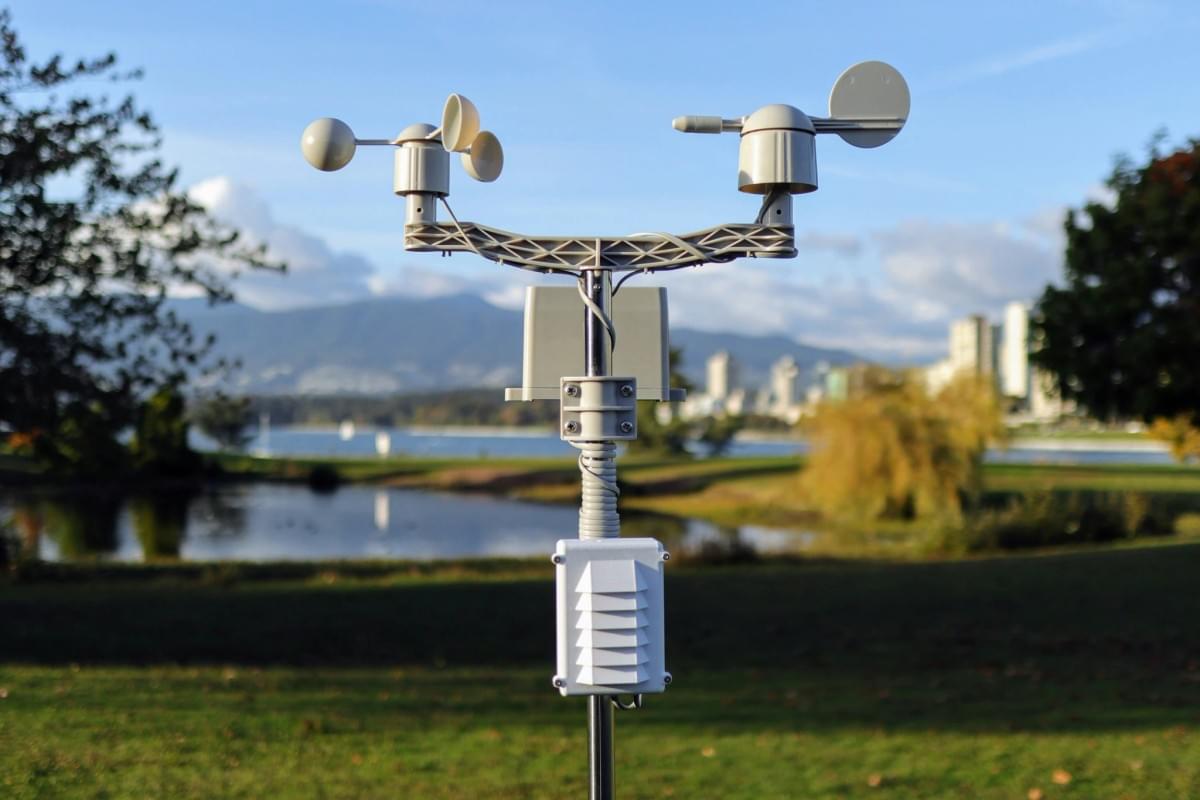
2.4 Pros and Cons of ASOS
Pros of ASOS
Delivers comprehensive, multi-parameter weather data
Integrates with ATIS, CTAF, and ATC systems
Automatically alerts for severe weather
Operates 24/7 without human error
Cons of ASOS
Higher upfront installation cost compared to AWOS
More complex maintenance (requires specialized technicians)
Overkill for small airports with low traffic
Higher long-term maintenance costs
3. What Is AWOS? A Deep Dive into Automated Weather Observing Systems
AWOS stands for Automated Weather Observing System—a streamlined, cost-effective alternative to ASOS, designed for smaller airports, heliports, and remote airfields. While AWOS shares the same core goal (providing real-time weather data), it focuses on essential parameters rather than comprehensive monitoring—making it ideal for facilities with limited budgets or simpler operational needs.
3.1 Core Definition of AWOS
AWOS is an automated system that collects and reports basic surface weather data at airports where full ASOS capabilities aren’t necessary. It prioritizes the most critical parameters for safe flight (e.g., wind, visibility, and temperature) and delivers data in a simple, easy-to-access format (via radio, phone, or digital platforms). Like ASOS, AWOS operates 24/7 without human intervention—but it’s built to be affordable and low-maintenance.
3.2 Key Components of AWOS
AWOS relies on a smaller set of sensors than ASOS, focusing on “need-to-know” data for pilots. Its core components include:
- Anemometers: Measure wind speed, direction, and gusts (updated every 5–10 seconds).
- Thermometers & Hygrometers: Track temperature and relative humidity.
- Barometers: Monitor atmospheric pressure (critical for calculating altitude).
- Visibility Sensors: Measure horizontal visibility (typically down to 1 mile, depending on the model).
- Data Display Units: Make data accessible to pilots via:
- Radio broadcasts (on local frequencies)
- Toll-free phone lines
- Digital platforms (e.g., airport websites or aviation apps)
- Optional Add-Ons: Some AWOS models offer extra features (for an additional cost), such as precipitation detection or cloud height sensors—but these are not standard.
3.3 Ideal Use Cases for AWOS
AWOS is the go-to choice for facilities where simplicity and cost-effectiveness matter more than comprehensive data. Its most common applications include:
- Small regional airports (with fewer than 50 daily flights)
- General aviation airfields (used by private planes, flight schools, or charter services)
- Heliports (e.g., medical evacuation helipads or offshore oil rig heliports)
- Remote airports (in rural areas or wilderness regions, where maintenance resources are limited)
- Unmanned Aerial Vehicle (UAV) bases (where drone operators need basic weather data)
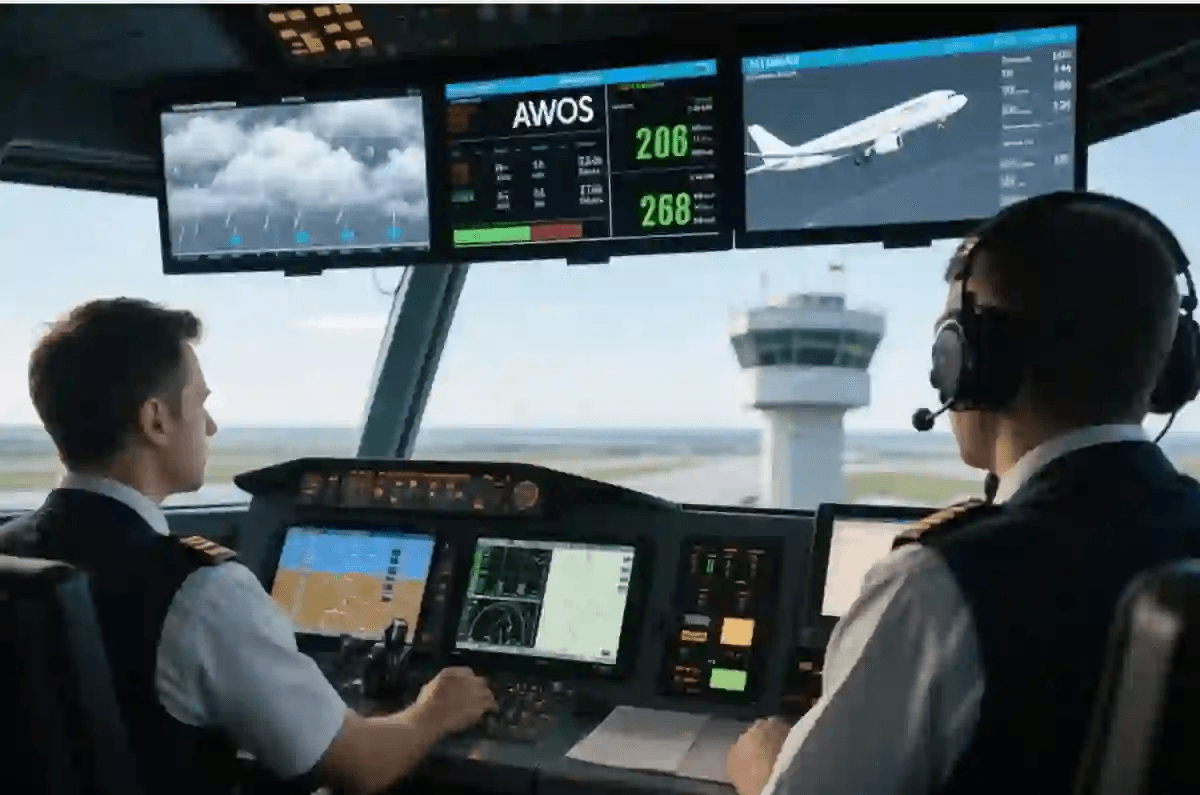
3.4 Pros and Cons of AWOS
Pros of AWOS
Lower upfront and maintenance costs than ASOS
Simple installation (can be set up in days, not weeks)
Low maintenance (uses durable, easy-to-service sensors)
Ideal for small airports with tight budgets
Cons of AWOS
Limited parameter monitoring (no cloud height or precipitation type by default)
Does not integrate with ATIS/ATC systems by default (requires add-ons)
No automated severe weather alerts (pilots must monitor data manually)
Less accurate for complex weather conditions (e.g., fog or thunderstorms)
4. The Difference Between ASOS and AWOS: A Side-by-Side Comparison
Now that we’ve defined ASOS and AWOS individually, let’s break down their key differences—from functionality to cost. This comparison will help you decide which system is right for your airport or operation.
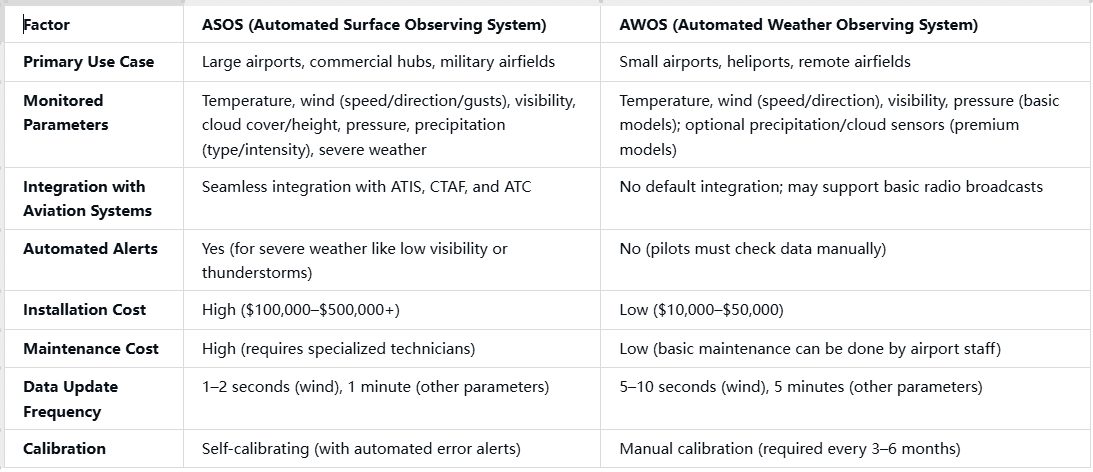
5. What’s Better: ASOS or AWOS? How to Choose
The answer to “Which system is better?” depends entirely on your operational needs and budget. There’s no “one-size-fits-all” solution—here’s how to decide:
5.1 Choose ASOS If:
- You manage a large airport with commercial airline service or high traffic volume.
- Pilots and ATCs need comprehensive data (e.g., cloud height, precipitation type) to make safe decisions.
- You need integration with ATIS, CTAF, or ATC systems (standard for busy airports).
- Severe weather alerts are critical (e.g., if your airport is in a region prone to fog, thunderstorms, or snow).
- Budget is not a primary constraint (you can afford higher installation and maintenance costs).
5.2 Choose AWOS If:
- You manage a small airport, heliport, or remote airfield with low traffic.
- Pilots only need basic data (wind, visibility, temperature) for safe operations.
- Budget is tight (you need an affordable, low-maintenance solution).
- Maintenance resources are limited (you don’t have access to specialized technicians).
- You don’t require integration with ATIS or ATC (e.g., at non-towered airports).
5.3 Real-World Examples
- Example 1: International Airport: London Heathrow uses ASOS because it needs to manage 1,300+ daily flights, integrate with ATC, and alert pilots to fog (a common issue in the UK). ASOS’s cloud height and visibility sensors are critical for preventing delays and accidents.
- Example 2: Rural Airfield: A small airport in Montana (used by private planes and flight schools) uses AWOS. Pilots only need to know wind speed and visibility for takeoffs/landings, and the airport can’t afford ASOS’s maintenance costs.
- Example 3: Medical Heliport: A hospital heliport in Texas uses a premium AWOS model with optional precipitation sensors. It needs basic data for emergency medical flights but can’t justify ASOS’s cost—so the add-on sensors provide just enough extra safety.
6. How Haisen’s Aviation Automatic Weather Station Enhances ASOS and AWOS
Whether you choose ASOS or AWOS, Haisen’s Aviation Automatic Weather Station is designed to upgrade your system—filling gaps in data, improving accessibility, and boosting safety. Haisen’s solution isn’t a replacement for ASOS/AWOS; it’s a complement that makes these systems more powerful and user-friendly.
6.1 Key Features of Haisen’s Weather Station
- Enhanced Sensor Technology: Haisen’s sensors are more accurate than standard ASOS/AWOS components—especially for visibility, cloud height, and precipitation. For example, its visibility sensor can detect fog down to 1/8 mile (vs. 1/4 mile for standard ASOS), and its cloud height detector works in low light (critical for night flights).
- Unified Data Platform: Haisen’s cloud-based dashboard pulls data from ASOS/AWOS and displays it in a single, easy-to-read interface. Pilots can access real-time updates via mobile app, while airport managers can track trends (e.g., monthly wind patterns) for long-term planning.
- Seamless Integration: Haisen’s system connects with existing ASOS/AWOS units, ATIS, and CTAF—no need to replace your current setup. It also integrates with third-party tools (e.g., flight planning software) to streamline operations.
- AI-Powered Alerts: Unlike standard ASOS/AWOS, Haisen’s station uses AI to predict weather changes (e.g., “Fog will reduce visibility to 1/2 mile in 30 minutes”) and send proactive alerts to pilots and ATCs.
- Low Maintenance: Haisen’s sensors are durable and self-cleaning (resistant to dust, snow, and rain), reducing maintenance costs by 30% compared to standard ASOS/AWOS components.
6.2 Benefits for Airports and Pilots
- Improved Safety: Proactive alerts and more accurate sensors help pilots avoid hazardous conditions (e.g., sudden wind gusts or rapidly decreasing visibility).
- Cost Savings: For AWOS users, Haisen’s add-on sensors (e.g., cloud height detectors) let you get “ASOS-like” data without paying for a full ASOS system. For ASOS users, Haisen’s low-maintenance components reduce long-term costs.
- Efficiency: The unified dashboard saves pilots and ATCs time—they no longer need to check multiple platforms for weather data.
- Scalability: Haisen’s system grows with your airport. Start with basic sensors, then add features (e.g., precipitation detection) as your needs change.
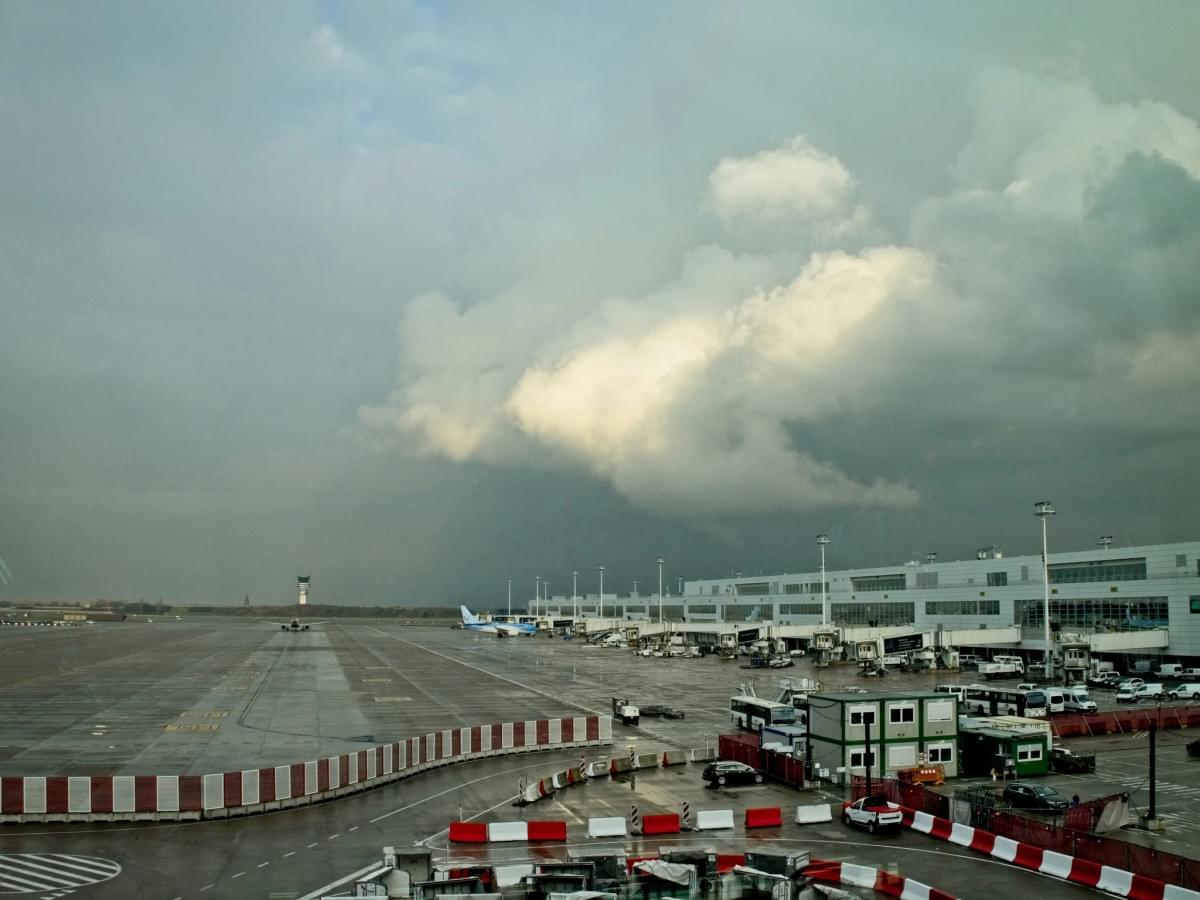
7. Conclusion: Prioritize Safety with the Right Weather System
ASOS and AWOS are both critical for aviation safety—but the difference between ASOS and AWOS means choosing the wrong system can compromise safety or waste resources. To recap:
- ASOS is for large, busy airports that need comprehensive data and integration with aviation infrastructure.
- AWOS is for small, budget-conscious facilities that only need basic weather information.
And with Haisen’s Aviation Automatic Weather Station, you can enhance either system—adding accuracy, accessibility, and proactive alerts to keep pilots safe and operations smooth.
If you’re still unsure which system (or upgrade) is right for your airport, Haisen’s team of aviation weather experts can help. We’ll assess your operational needs, budget, and location to recommend a solution that prioritizes safety and efficiency. Contact us today to schedule a demo or get a custom quote.
8. FAQs About ASOS and AWOS
- Q: Can AWOS be upgraded to ASOS?
A: No—AWOS and ASOS are separate systems with different hardware and software. However, you can add Haisen’s sensors to AWOS to get “ASOS-like” data (e.g., cloud height) without replacing the entire system.
- Q: Do ASOS and AWOS work in extreme weather?
A: Yes—both systems are designed to operate in harsh conditions (e.g., -40°C to 50°C, high winds, or heavy rain). Haisen’s sensors are even more durable, with resistance to corrosion and extreme temperatures.
- Q: How often do ASOS and AWOS need maintenance?
A: ASOS requires monthly maintenance (by specialized technicians), while AWOS needs quarterly checks (can be done by airport staff). Haisen’s system reduces maintenance frequency by 30% due to self-cleaning sensors.
- Q: Can pilots access ASOS/AWOS data in the air?
A: Yes—pilots can access data via radio (CTAF for ASOS, local frequencies for AWOS), mobile apps (if integrated with Haisen’s platform), or toll-free phone lines.

